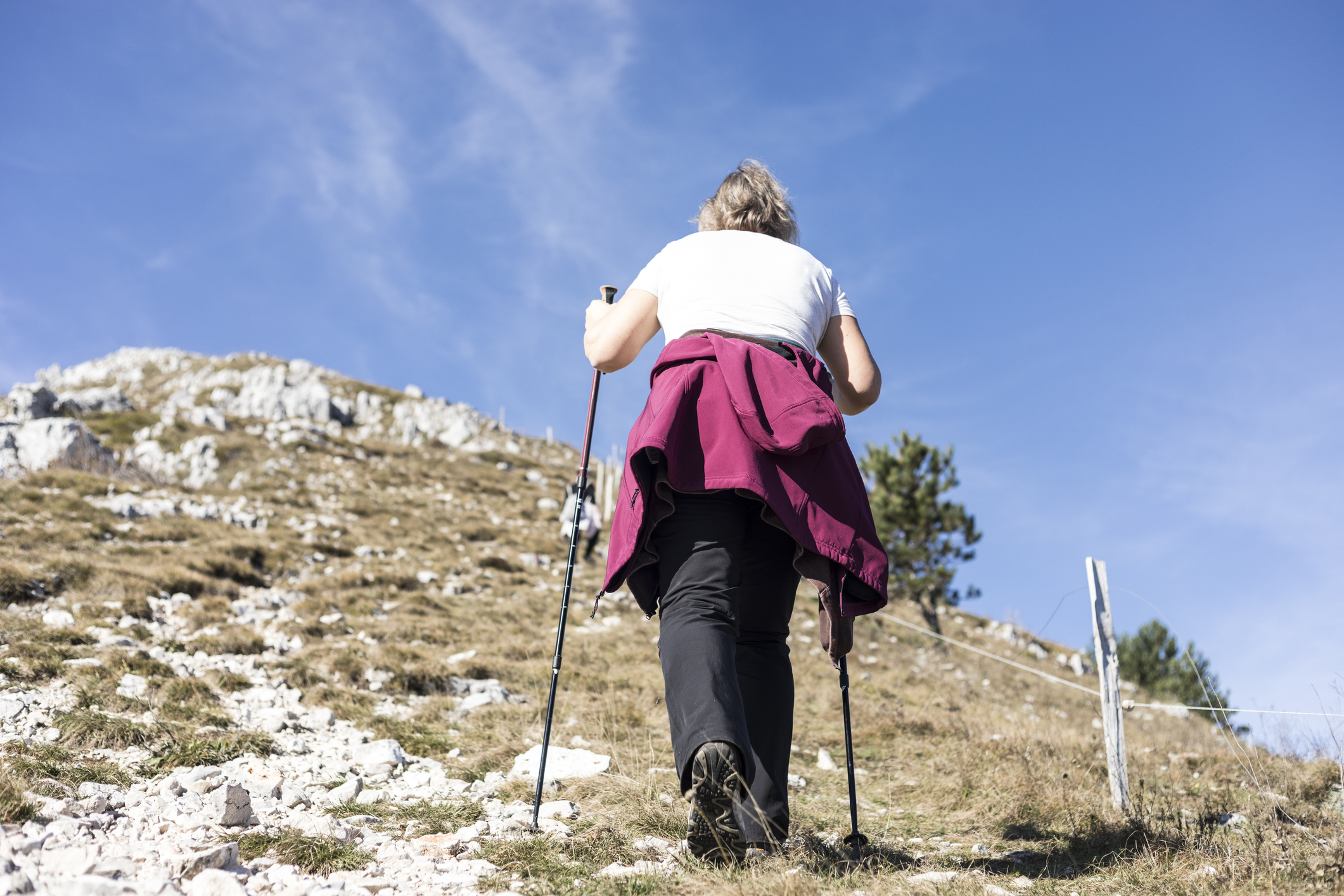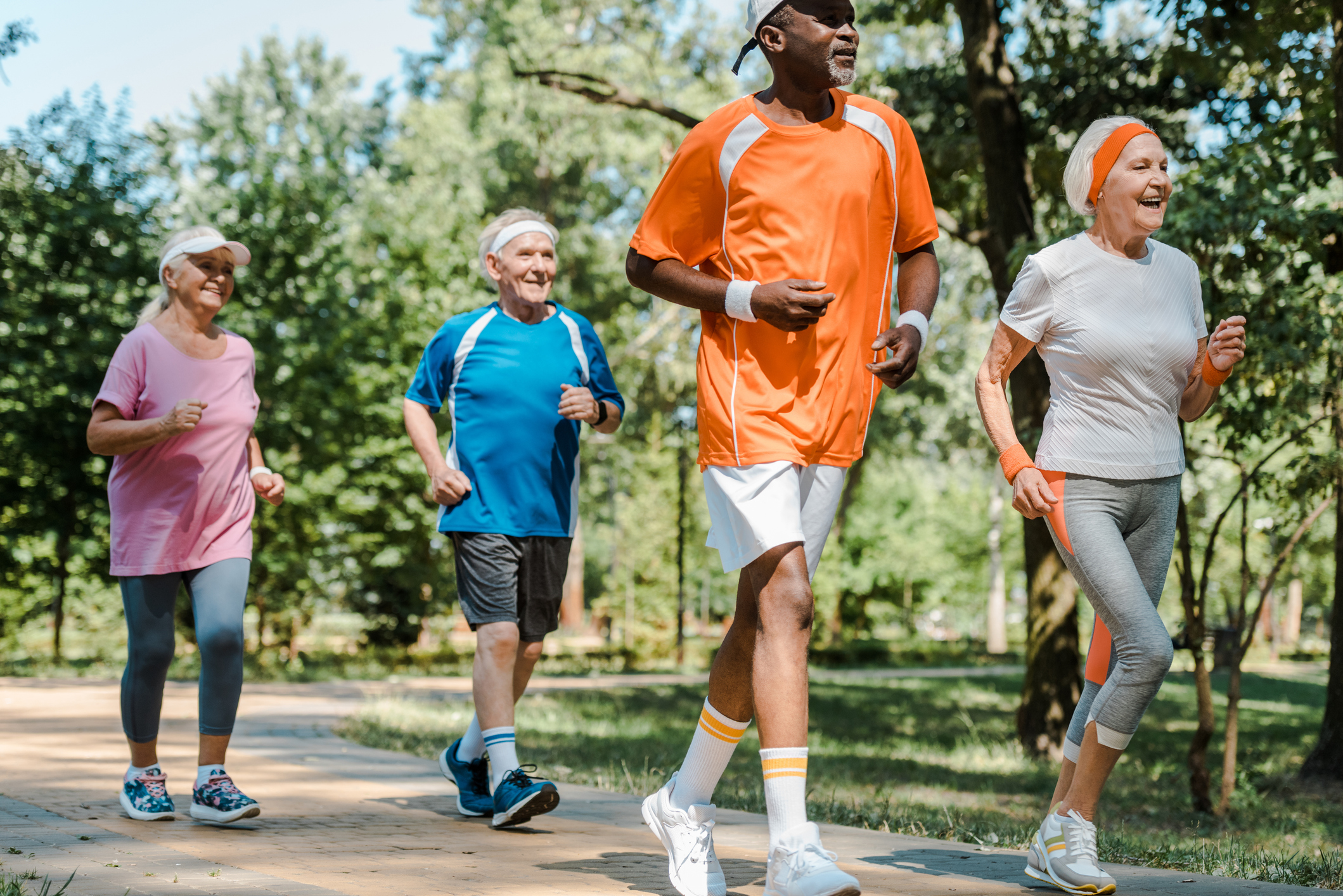SUMMARY: Older adults (OAs) should prioritize the important actions that support successful aging like cardio…

THE IMPORTANCE OF DOING HARD THINGS: CARDIO EDITION
SUMMARY: Compelling research suggests improving our cardiovascular (aerobic) fitness capacity supports a longer life/health span. To improve our aerobic capacity, the intensity of effort is key, so aerobic exercise needs to be a physically “hard (enough) thing”. The most accessible way to gauge our aerobic exercise intensity is the 10-point relative perceived exertion scale (RPE).
INTRO
To age well, we should always be looking to implement strategies to optimize our functional ability and minimize chronic disease risk.
To optimize function, older adults (OAs) must regularly challenge their physical capabilities by doing “hard things” and, last post, I emphasized the number one “hard thing” is resistance exercise (RE).
This post, the focus is the number two “hard thing” for OAs, aerobic exercise (cardio) performed with enough intensity and consistency to maintain, raise, or even maximize, our aerobic fitness capacity (1).
You may think: I walk a lot, does that count, and is it “hard enough”? The answer to that question is maybe. For OAs, any physical activity is probably a net positive – particularly walking (2) – but if your walking doesn’t have enough intensity of effort to raise your aerobic capacity, the science seems to show you’re likely not capturing potential longevity & health benefits.
To optimize your aging potential, there’s a clear research-supported hierarchy of exercise: 1) sufficiently challenging RE; and 2) medium/high intensity cardio. Aging specialists put RE in first place because strength is the foundation for all the physical capacities (functional abilities) OAs need to nurture, and this includes aerobic capacity and endurance.
So, for our purposes, RE & cardio are a matched pair – you can’t afford to neglect one or the other to age well. And also realize they synergistically support each other when we team them up as part of our physical lives: RE enhances our strength, physical structure and neuromuscular function which allows our bodies to withstand and perform cardio better, while cardio enhances circulation in multiple ways described below, which is key to allowing oxygen & nutrients to get to our muscles to improve functional performance and develop new muscle tissue as an adaptive response to RE (3).
OPTIMIZING OUR BLOOD’S CIRCULATION ABILITY
Often overlooked as a vital condition for optimal aging is the ability of our blood to circulate freely to every cell in our body. With aging, our arteries will stiffen and often fill up with atherosclerotic (cholesterol-filled) plague, such that Atherosclerotic Cardiovascular Disease (ASCVD) (4) is our number one killer, with our risk of ASCVD going up markedly with advancing age. Besides ASCVD, poor circulation is directly linked to many other issues which affect OAs health & quality of life: dementia, kidney disease, hearing loss, muscle loss (5), erectile dysfunction, peripheral nerve problems, slow wound healing, toenail fungus, and many others.
Optimizing our circulation means not smoking and maintaining blood pressure, cholesterol (6), and blood sugar at optimal levels, but equally import is maximizing our aerobic fitness by performing medium/high intensity cardio consistently. Extensive research reviewed below supports the idea that achieving high aerobic fitness capacity is of equal or even greater importance as optimizing the common ASCVD risk factors mentioned above.
Appropriately intense & consistent cardio will improve the function of our circulatory system via multiple mechanisms and pathways and, in addition, also improves most ASCVD risk factors as well. But the really exciting thing about cardio is it can actually create NEW blood vessels: yes, new blood vessel formation is termed “increased capillary density” (7), and is a very well-studied adaptive response to consistent cardio.
THE SCIENCE FOR OPTIMIZING OUR AEROBIC CAPACITY
The health & longevity benefits of nurturing our aerobic fitness capacity are strongly supported by research; so much so, the American Heart Association issued a scientific statement advocating for aerobic fitness capacity as a clinical vital sign (8) to be measured regularly in everyday medical practice to help guide treatment recommendations.
When aerobic fitness capacity is objectively measure via a maximal treadmill test (1) there is a very compelling inverse relationship between aerobic fitness and death from all causes (all-cause mortality) which has been shown in multiple large-scale studies reviewed below. When reading the key findings of these studies, please especially note two main points:
- The strikingly consistent and similar results across all three studies which represent nearly one million combined subjects (885,653).
- The greatest proportional longevity benefit was associated with avoiding the lowest aerobic fitness categories: so even having just moderate aerobic fitness produced major decreases in all-cause mortality.
Three of the most important studies supporting the idea that your aerobic capacity is directly and strongly associated with your longevity and health status (9) are authored by Drs. Steven Blair, Kyle Mandsager, and Peter Kokkinos and we briefly review each below.
DR. BLAIR’S 1989 STUDY AT THE COOPER CLINIC is considered a “landmark study” and measured aerobic fitness levels via maximal treadmill test in 10,224 men & 3120 women, and segregated subjects by age, sex and into five levels of aerobic fitness, and then followed for 8+ years.
Key findings:
- There was a marked step-wise increase in all-cause mortality rates from highest aerobic fitness (least mortality) to lowest aerobic fitness (greatest mortality).
- The risk of death was 344% greater for the least fit group of men compared to the most fit, and for women the difference was 465%!
- Greater aerobic fitness levels were associated with decreased all-cause, ASCVD, and cancer mortality.
- Poor aerobic fitness predicted an increased risk of death to an equal or greater degree than having the common risk factors for ASCVD like smoking, cholesterol, blood pressure, etc.
- It’s really worth noting that the greatest decrease in risk of death was avoiding the lowest aerobic fitness category.
DR. MANDSAGER’S 2018 STUFY AT THE CLEVELAND CLINIC had over 10x the number of subjects as Dr. Blair’s study. Dr. Mandsager’s team measured aerobic fitness via treadmill stress test for 122,007 individuals (41% female) and followed them for an average of 8 years and segregated the subjects by age, sex, and into 5 fitness levels by percentile rank: low, below average, average, above average, and elite.
Key findings:
- All-cause mortality showed a striking step-wise decrease from low (highest risk) to elite (lowest risk).
- The elite fitness group had an 80% less mortality risk compared to the low fitness group: expressed differently, the low fitness group had a 500% greater risk of death than the elite group!
- Like Dr. Blair’s study, the risk of death for low aerobic fitness capacity was equal or greater than having common risk factors for ASCVD including already having heart disease – so having low aerobic fitness conveyed a greater risk of death than having heart disease!
- When looking at the mortality risk reduction between the two highest aerobically fit groups (above average to elite group), only the 70+ age group reached statistical significance, which suggests that maximizing aerobic fitness is particularly important for OAs aged 70+.
- Like Dr. Blair’s study, the greatest decrease in risk of death was avoiding the lowest aerobic fitness category.
DR. KOKKINO’S 2022 STUDY AT WASHINGTON DC VETERANS AFFAIRS MEDICAL CENTER measured aerobic fitness via a maximal treadmill test in 750,302 veterans aged 30 to 95 years and contained data for a significant number of women, OAs, African Americans, Hispanics, and Native Americans, and an average follow up of 10 years. Subjects were segregated by age, sex, race and aerobic fitness capacity, with 6 fitness categories determined by percentile ranking: least fit, low, moderate, fit, highly fit, and extremely fit (=/> 98th percentile).
Key findings:
- Like Drs. Blair & Mandsager’s studies, there was a consistent & strong step-wise, inverse relationship between aerobic fitness capacity and risk of death across all ages, races and sexes.
- The risk of death for the least fit category was over 400% greater than the extremely fit category!
- The greatest decrease in mortality risk was from the least fit to moderately fit category, so once again like Drs. Blair & Mandsager’s studies, avoiding the least aerobically fit category was hugely important.
- For every 1 MET (1) increase of aerobic fitness capacity, there was a 14% reduction in risk of death.
- Again, like Drs. Blair & Mandsager’s studies, having poor aerobic fitness capacity conferred a greater risk of death than 9 co-morbidities like smoking, hypertension, diabetes, ASCVD, etc.
- 80% of men and 95% of women in the extremely fit category were alive at 20 years versus 40% of men and 75% of women in the least fit category.
- Men & women in the extremely fit category lived 6/6.7 years longer respectively, than men & women in the least fit category.
ESTIMATING YOUR CARDIO INTENSITY USING RPE SCALE
What’s the best way to determine what medium or high intensity cardio means for you? In my opinion, the most accessible way is the 10-point Modified Borg Perceived Exertion Scale (RPE). Here’s a nice overview of the concept published by the Cleveland Clinic.
Just below is a little coaching to effectively use the 10-point RPE scale to estimate the intensity of your cardio session. I’ve broken the RPE scale into six commonly used numerical groupings:
10-Point RPE Scale
1 – “Very Light” (anything more than resting physical effort)
2/3 – “Light” (physical effort is quite doable; could sustain for quite a while; talking easy to do)
4/5 – “Moderate” (somewhat challenging effort; talking a bit “breathy”; have to push a little)
6/7 – “High Intensity” (clearly a challenging effort; takes will & focus to keep pushing yourself)
8/9 – “Very High Intensity” (super intense effort and very difficult to maintain this level)
10 – “Maximum Intensity” (maximal effort; nothing left to give; can sustain for very brief time)
The most important thing to keep in mind is this 10-point RPE intensity scale is individualized to you – the numerical “score” is what you and your body say & feel that it is. Take into account all of your physical sensations, not just breathing, and make a judgement call minute-by-minute.
Second, if your health care providers give you cardio recommendations, try to get intensity guidelines based on the 10-point RPE scale so you’ve got some clarity to put their recommendations into action.
Third, if you have no medical or physical reason not to, make sure you get yourself to 4/10 or above – ideally, we want a blend of cardio intensities as they won’t all be “7”, nor should they be – but cardio intensity at least needs to be on your radar. I know, some days any intensity might seem impossible and a victory is just doing something physically active. That sometimes happens to me the day after a hard RE session or a night of poor sleep, so I do joint/tissue mobility work and/or go for a non-taxing walk. But, if your body is ready for it, try to PUSH yourself up into 4, 5, 6, or even 7 range on your personal 10-point scale.
Fourth, understand your numerical intensity rating can and probably will change a bit within a cardio session. It will be low at the beginning & end for a brief warmup/cooldown and may reach a peak before fatigue compels you to lower it. Perhaps you may get a “second wind” which allows you to raise your intensity a bit mid-session. Or you may want to vary your intensity purposely during a cardio session, which is a great strategy for stimulating greater aerobic fitness adaptations, gradually accommodating your body to a greater cardio intensity, or getting the most your body is capable of during a cardio session.
Lastly, if you’re currently doing little to nothing in the way of cardio, starting & staying a while in the 2-3/10 range is never a bad idea. Or, if you’re currently staying in the 1-3/10 range, add the extra intensity in small doses and gradually. When looking to dial your intensity up for the first time, just become familiar with what a 4/10 feels like for you and see how your body responds the extra effort – that’s a big victory! – and then you can take it from there…
Footnotes:
(1) Your aerobic capacity is also called your cardiovascular fitness capacity or cardiorespiratory fitness capacity. Aerobic capacity is commonly expressed as VO2 Max, and is often measured in OAs via a graded exercise test, called a maximal treadmill test or treadmill stress test. The time duration and slope/elevation grade you’re able to achieve on the treadmill test provides a very close estimate of your VO2 Max. VO2 Max is most often expressed in METs, which stands for metabolic equivalents. One MET is the amount of oxygen we use while at rest, which when expressed in relative terms, is 3.5ml/kg/min (milliliters of oxygen per kilogram body weight per minute). The more METs you can achieve during a graded exercise test, the greater your aerobic fitness capacity. You can think of your max MET capacity as your aerobic reserve over & above resting levels, or how high you can “rev” your aerobic engine above resting.
(2) There is lot of research to support the idea that the more you walk, the longer you will live.
(3) One of the postulated mechanisms for anabolic resistance (see footnotes 5 & 7 below) is lack of blood flow to and within the muscle tissue (microcirculation) which makes it more difficult to take up the nutrient building blocks needed to synthesize the proteins to make new muscle tissue – or not lose existing tissue with age. Increasing capillary density via cardio exercise improves our microcirculation and promotes anabolic (building up) capability for OAs.
(4) ASCVD includes chest pain (angina), heart attack, cardiac arrest & sudden death, stroke and peripheral vascular disease in leg muscles.
(5) Muscle loss associated with aging is called sarcopenia, and often becomes a serious problem for OAs as we age – see my previous post. Anabolic resistance is a closely related concept and is a mechanistic way of saying OAs have a harder time assembling (synthesizing) new muscle tissue and preventing loss of muscle tissue with aging; in part the result of loss of capillary microcirculation (see footnote 7 below) adjacent to muscle tissue cells.
(6) LDL cholesterol (LDL-C) is commonly measured for blood cholesterol status, but Apo B, which stands for Apolipoprotein B, measures all of the atherogenic (capable of contributing to the atherosclerotic process inside our arteries) particles in blood, so it is considered the best available measurement for ASCVD risk due to blood cholesterol status. Other ASCVD modifiable risk factors besides the ones mentioned is obesity, particularly abdominal (termed visceral or central obesity) and systemic inflammation.
(7) Capillaries are our smallest blood vessels which are adjacent to the cells/tissues where nutrient & gas exchange (oxygen & CO2) occurs.
(8) This is akin to the measurement of heart rate, breathing rate, blood pressure, body temperature and oxygen saturation, the common vital signs in clinical practice.
(9) When you read the study’s findings, you may be thinking “of course the lowest fitness categories had more death and disease because these subjects were already sick or very unhealthy” – this is called reverse causation and is a reasonable assumption. But, if you read the studies, you will see the authors have done all they can to exclude reverse causation by omitting specific groups of subjects and statistically adjusting for as many confounding physical factors or attributes which might skew or bias the results.



